PY 131 Chapter 26: Properties of Light
Light
Surrounding any electric charge is an electric field.

Surrounding any moving charge is a magnetic field.
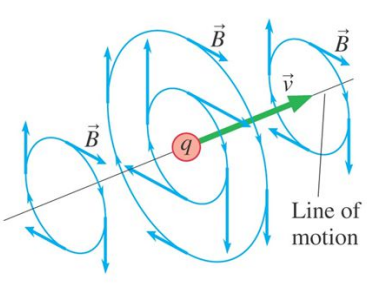
Consider a charge which is oscillating in space.
- the charge is continually changing its velocity i.e. it is accelerating.
As the charge oscillates the electric and magnetic fields around it have to change with time.
Maxwell’s addition to Ampere’s Law states that a changing electric field produces a magnetic field.
Faraday’s Law states that a changing magnetic field produces an electric field. The disturbances in the fields move away from the charge.
- Maxwell calculated this speed to be 300,000,000 m/s or 186,000 miles per hour. FYI the circumference of Earth is 24,901 miles. https://www.compadre.org/osp/EJSS/4126/154.htm
Propagating disturbances in the electric and magnetic fields surrounding accelerating charges are called light.
If we focus upon the disturbed parts of the fields then along a given ray away from the charge, the disturbances in the fields are transverse to the ray and look like

the disturbances in the electric and magnetic fields are waves with a speed, frequency, wavelength and amplitudes.
The speed of light is often given the symbol c.
That light was a wave was already known well before Maxwell.
- experiments had shown that two light sources could interfere
- before Maxwell what wasn’t known was that it was a wave of
From interference experiments the wavelength of visible light had been measured to be ~500 nm.
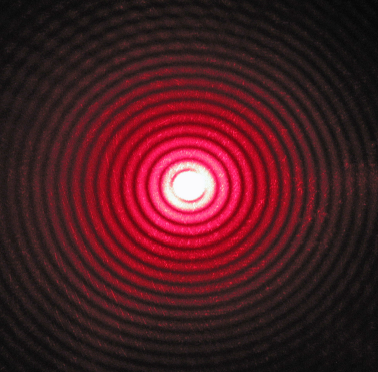
Diffraction pattern of light from a laser as it passes through a small hole in a screen
When part of a musical instrument vibrates (e.g. a string on a violin) it produces a note with the same frequency.
When an electric charge vibrates, the light it produces also has the same frequency.
- the slower the vibration the lower the frequency.
- but unlike a sound wave, light does not need a medium: electric and magnetic fields can exist in a vacuum.
There is no limit to the frequency at which a charge can vibrate. From the speed of light and the wavelength you can determine the frequency of visible light.
the value is an eye-popping ~500,000,000,000,000 oscillations per second i.e. ~ 5 x 1014 Hz
Maxwell found that the speed of light in a vacuum was the same for all frequencies.
The Electromagnetic Spectrum
- The range of all possible frequencies of light is called the electromagnetic spectrum.
- The EM spectrum is divided up into different ranges with each range given a name.
- The usual 7 categories of light are:
- Radio waves
- Microwaves
- Infrared
- Visible
- Ultraviolet
- X rays
- Gamma rays
- The boundaries between the different categories are not sharp, they blend from one to the next.
The interaction of light and matter
The oscillating electric and magnetic fields produced by accelerating charges propagate away from the charge.
When those oscillating electric and magnetic fields encounter another free charge, they will cause it to start moving.
- the charge gains kinetic energy from the light so the light transfers
energy from one charge to another. - the energy content of the light depends upon the amplitude of the
electric and magnetic fields - as the energy gets transferred to the charge, the amplitudes of the electric and magnetic fields must get smaller.
- the charge gains kinetic energy from the light so the light transfers
The oscillating charge will emit light of its own in all directions
- the charge doesn’t store the energy it absorbed.
However most charges (electrons and protons/nuclei) are not free to move, they are bound inside atoms and molecules.
An electron in an atom/molecule can only have particular amounts of energy (the same is true for protons in the nucleus).
The electron can absorb energy from the light only if the frequency of the light is a particular value.
- strong absorption of light occurs when the frequency is on resonance with the natural frequency of the electron
Which frequencies are absorbed are unique to each element.
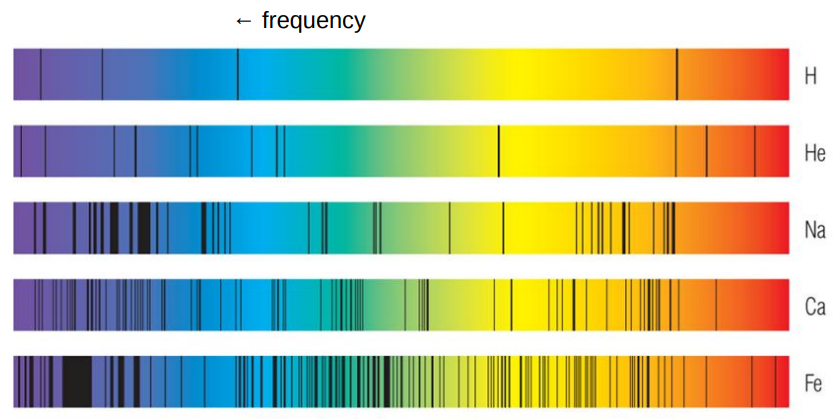
When atoms are close to one another as in a liquid or solid, the absorption lines become wider.
If the light passing by an atom/molecule cannot be absorbed, the atom/molecule still affects the light.
- the atoms/molecules become polarized and/or magnetized and their polarization/magnetization fields alter the speed of light.
The ratio of the speed of light in a vacuum to the speed of light in a material is called the index of refraction of that material.
- index of refraction = speed of light in a vacuum / speed of light in material
the index of refraction for water is 1.333
the index of refraction of glass is ~1.5
the index of refraction of diamond is 2.42
These are at visible frequencies: some materials can have indicii of refraction closer to 10 for other types of light.
Materials which do not absorb light are ==transparent.==
Transparency depends upon the frequency of the light.
For example, glass is transparent for visible light but glass absorbs ultraviolet and infrared light
Materials which absorb light are said to be ==opaque.==
The energy given to an electron that absorbed the light is then shared among the other atoms/molecules in the material and raises the average kinetic energy – i.e. the temperature rises.
EXAMPLE 1
What do radio waves infrared radiation, visible light, UV, X-rays and gamma rays have in common?
- ==they are all forms of light==
Shadows
Light travels in a straight line. A thin beam of light is called a ray.
Consider a point source of light and an opaque object.

Behind the object is a region called the umbra (shadow) where no light from the source can be found.
The edge of the umbra is the ray that just grazes the edge of the object.
If the light source has a finite size then in addition to the umbra, there is a region called the penumbra where some, but not all, the light can reach.

The edge of the penumbra and umbra are again defined by the rays from the edge of the source which graze the object.
For an extended source the umbra has a finite length if the source size is greater than the object size; if it is smaller then the umbra is infinite.
The penumbra is always infinite and decreases in size relative to the umbra as the source becomes smaller or the object moves away.
From the surface of Earth the Moon and Sun have, coincidentally, the same size in the sky
- they are not actually the same size, the Sun is much bigger than the Moon but the Moon is a lot closer.
If the Moon comes between the Earth and Sun then it’s umbra and penumbra can intersect the surface of the Earth.
- Such an event is called a solar eclipse.
Inside the umbra no part of the Sun can be seen: inside the penumbra only part of the Sun can be seen.
- the Sun is said to be partially eclipsed inside the penumbra and totally eclipsed inside the umbra.
The Sun is much bigger than the Moon so the umbra has a finite length.
A solar eclipse where the umbra does not touch Earth’s surface is called an annular eclipse.
- annular means ‘ring’, not that it happens every year
If the Moon passes through the umbra or penumbra of Earth then we call this a lunar eclipse.
due to light bent by Earth’s atmosphere the umbra from Earth on the Moon is not completely black, it is a very faint red.
The Eye
The trajectory of light that enters the eye is changed by the shape of the cornea and lens.
Rays of light are made to converge to a point that is on the retina of the eye.
The process of making rays converge to a point is called focusing the light.
By focusing light every point on a hypothetical spherical surface surrounding the eye is mapped to a point on the retina.
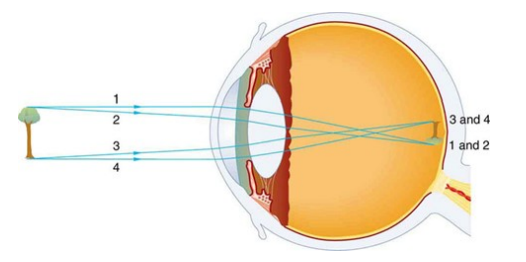
The point where the rays cross is called the ==focal point.==
If the focal point is not exactly on the retina then the image is blurred.
Objects in space are not all at the same distance from us so a single lens cannot focus the light from them all onto the retina at the same time.
There is a range of distances called the depth of field where all the objects are in focus.
- an object outside the depth of field will appear blurred.
Blurry vision can also occur because the eye cannot correctly focus light onto the retina.
- For example the shape of the eyeball or cornea is not spherical, or the lens cannot adjust to be the shape necessary to focus the light.
Located on the retina are two different types of photoreceptor cell colloquially called rods and cones.
There is a third type of photoreceptor cell called intrinsically photosensitive retinal ganglion cells but they are not related to vision.
Rods are sensitive to brightness, cones are sensitive to color.
Cones require bright light to function well.
Cones come in three types called S-cones, M-cones and Lcones.
- S, M, and L stand for short, medium and long
S-cones are most sensitive to blue light which has a shorter wavelength
M-cones are most sensitive to green light which has a medium wavelength
L-cones are most sensitive to the longer wavelength red light.
Rods are more sensitive to blue-green light than red
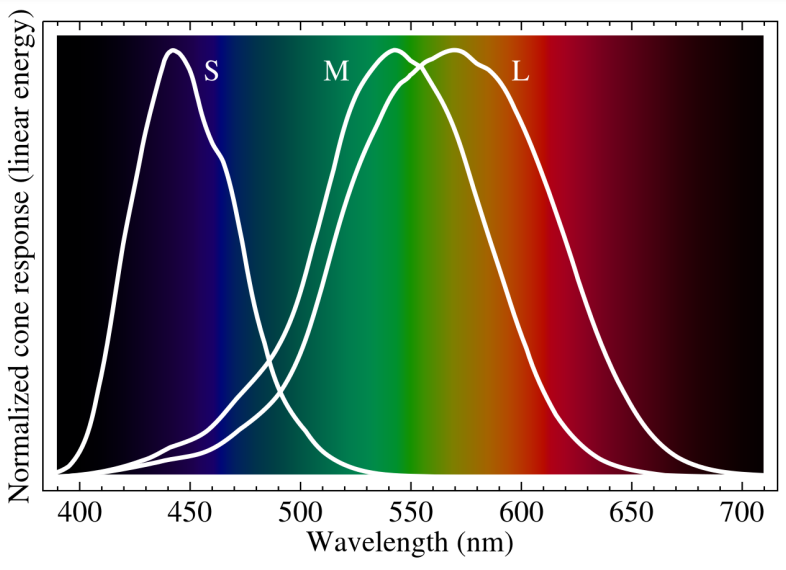
What we call visible light is simply the light that is capable of triggering a response from the cones on our retina.
- some birds and insects have cones on their retinas which respond to light that our cones do not.
The range of wavelengths of light which form visible light is from ~400 nm to 700 nm, 4 x 1014 Hz to 7 x 1014 Hz. Light with the lowest frequency, and longest wavelength is red, and the highest frequency, the shortest wavelength is violet.
- traditionally the six (seven) colors of the visible light spectrum (rainbow) are: red, orange, yellow, green, (cyan) blue, (indigo), and violet.